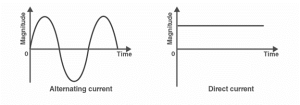Introduction
Over the past many centuries, the world has witnessed several discoveries. The discovery of electric current was one such invention that changed the way people led their lives.
Today, in this article, we will explain one of the most crucial chapters of physics, alternating current, and topics related to it.
What is Current Electricity?
Before we jump directly into today’s topic, the alternating current, it is crucial to glimpse current electricity and what it exactly is. Current can be defined as the total time in which electrons flow from one point of the circuit. I donate the current electricity. The man behind this incredible invention is Benjamin Franklin.
Here, I = q/t = total total time/charge flowing, and
Iavg = Δq/Δt
Instantaneous = dq/dt
One of the common examples of current electricity is lightning which travels from the sky to the earth. Apart from this, torches and clocks are the most common examples of current electricity. Further, current electricity is divided into two major types, including the direct current donated by DC, and the alternating current is known as AC.
Let’s further discuss AC in detail!
What is an Alternating Current?
Alternating current or AC can be defined as the electric current where the direction of the current electricity keeps on changing. AC changes its polarity and magnitude at regular intervals. This occurs due to regular fluctuation in the voltage leading to periodic back and forth for the current. Of the two, alternating current is the most preferred current used in household equipment.
The above graph shows that direct current flows in a defined direction, whereas the alternating current increases to a maximum and then returns to zero after a certain point. Later, the particles change their direction and again reach their maximum point. The same cycle keeps on repeating again and again.
Generation of the Alternating current
The device used to generate or produce the alternating current is the alternator. However, several methods are used where the alternating current can be produced. One of the most common is producing alternating current using a single-coil AC generator with a single wire loop and two-pole magnets in a rectangular shape.
Applications of Alternating Current
Alternating current is one of those types of current commonly used in electrical household appliances. A radio signal, audio signal, etc., are typical examples of alternating current. Since the alternating current is a safer option for transferring long distances without losing electric power, it is preferred to direct current, which is not suitable for travelling a long distance as it loses electric power.
Since energy is way easier in AC, it is mainly used in homes and offices. Also, AC is a reliable option as it can power electric motors, which further gives rise to mechanical energy through electrical energy. AC is not commonly found in household appliances such as dishwashers, refrigerators, etc.
Relation Between Alternating Current and Direct Current
Alternating current and direct current are related to each other as both are a type of current. To better understand direct and alternating current, let’s have a look at their definition-
Alternating Current
Alternating current can be defined as a current which keeps on changing its polarity and magnitude at a constant period. This occurs due to regular fluctuation in the voltage leading to periodic back for the current.
Direct Current
On the other hand, direct current is a type of current electricity whose magnitude and polarity remain constant. It can be defined by the regular flow of electrons that flow from the region of the higher density to the lower electron density.
Difference Between Alternating Current and Direct Current
Below, we have listed the significant differences between the direct current and alternating current in a tabular form for better understanding. Let’s have a look-
Alternating Current AC | Direct Current DC |
Alternating current is safer for transferring long distances without losing electric power. | On the other hand, the direct current is not suitable for travelling a long distance as it loses electric power. |
The magnets rotating around are responsible for the change in the flow of electric current. | Since the magnetism is steady, there’s no change in the direction of the flow of electric current. |
The frequency of the alternating current is dependent on the country. However, the frequency remains around 50 Hz to 60 Hz in general. | Direct current has absolutely no frequency. |
In AC, the current changes its flow and direction to the backward at regular intervals. | In the case of DC, there is no change in the flow of the direction. |
The electors present in alternating current keep changing their directions from backwards to forward. | In direct current, the electrons only move in the forward direction. |
Conclusion
Alternating current is a type of electric current which continuously changes according to its frequency. It is used in household appliances and for long range transfer as the power loss in these currents is very less. Then we compared AC current with DC current and got to know that DC current has some flaws which are covered by AC current.
 Profile
Profile Settings
Settings Refer your friends
Refer your friends Sign out
Sign out







